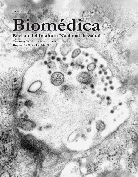Do some conditions contribute to the reemergence of the Venezuelan equine encephalitis virus in the Colombian Alta Guajira?
Abstract
Introduction: In the last 18 years, epizootics of Venezuelan equine encephalitis have not occurred in places with historic epidemic register (1925-1995) in the Guajira Peninsula, Colombia.
Objective: To assess if the Guajira Peninsula, Colombia, still maintains the epidemiological conditions for Venezuelan equine encephalitis virus reemergence.
Materials and methods: Research was carried out in places affected by the 1995 epidemic. We evaluated: 1) abundance and seasonal variation of vector mosquito populations; 2) availability of mammals that are potential amplifiers of the virus, and 3) knowledge among the community about the disease and its vectors.
Results: Most of the 16 mosquito species were found during the rainy season. Aedes taeniorhynchus and Psorophora confinnis showed direct relation with rainfall and temperature. In contrast, the dominant species, Deinocerites atlanticus, was always present in the collections, regardless of climatic conditions. No IgG antibodies were found in humans younger than 17 years old, goats or bovine sera. One third of those interviewed remembered the last epidemic and had basic understanding of the disease. Only 20% of the families were owners of equines, and 8% was informed of the importance of equine vaccination.
Conclusions: Some epidemiological conditions that eventually could help epizootic Venezuelan equine encephalitis virus reemergence are maintained. However, an abrupt decrease in the number of susceptible equines was found in the area. Apparently, this new condition has not allowed the virus reemergence and is the biggest observed change.
Downloads
Some similar items:
- Elsa Nieves, Néstor Villarreal, Maritza Rondón, Mireya Sánchez, José Carrero, Evaluation of knowledge and practice on tegumentary leishmaniasis in an endemic area of Venezuela , Biomedica: Vol. 28 No. 3 (2008)
- Lisbeth A. Hurtado, José E. Calzada, Vanesa Pineda, Kadir González, Ana María Santamaría, Lorenzo Cáceres, Coridalia Wald, Azael Saldaña, Knowledge and risk factors related to Chagas’ disease in two Panamanian communities where Rhodnius pallescens is the main vector , Biomedica: Vol. 34 No. 2 (2014)
- Karen López, Lilian Catalina Tartaglino, Ingrid Iris Steinhorst, María Soledad Santini, Oscar Daniel Salomon, Risk factors, representations and practices associated with emerging urban human visceral leishmaniasis in Posadas, Argentina , Biomedica: Vol. 36 (2016): Suplemento 1, Microbiología médica
- María Cristina Ferro, Victor Alberto Olano, Martha Ahumada, Scott Weaver, Mosquitos (Diptera: Culicidae) in the small village where a human case of Venezuelan equine encephalitis was recorded , Biomedica: Vol. 28 No. 2 (2008)
- Margarita Griffith, José Rovira, Rolando Torres, José Calzada, Carlos Victoria, Lorenzo Cáceres, Knowledge, attitudes and practices regarding malaria in the indigenous Guna population of the Madungandí region, Panamá, 2012 , Biomedica: Vol. 35 No. 4 (2015)
- Edgar Alfonso, Álvaro Sanabria, Mario Castillo, Surgeons overestimate the risk of malignancy in thyroid nodules, evaluation of subjective estimates using a bayesian analysis , Biomedica: Vol. 31 No. 4 (2011)
- Jefferson Antonio Buendía, Attitudes, knowledge and beliefs of patient about anti-hypertensive drugs , Biomedica: Vol. 32 No. 4 (2012)
- Beatriz Eugenia Alvarado, Alberto Alzate, Julio Cesar Mateus, Rocío Carvajal, Effects of an educational and participatory community intervention on malaria control in Buenaventura, Colombia , Biomedica: Vol. 26 No. 3 (2006)
- Flor de María Cáceres-Manrique, Mary Lupe Angulo-Silva, Celmira Vesga-Gómez, Efficacy of the social mobilization and the social participation in dengue control measures , Biomedica: Vol. 30 No. 4 (2010)
- María Paula Sarmiento, Oliverio Suárez, Jesús Antonio Sanabria, Cristhian Eduardo Pérez, Laura del Pilar Cadena, María Eugenia Niño, Knowledge and practices about the prevention and the control of the influenza A H1N1 in the community of Floridablanca, Santander , Biomedica: Vol. 31 No. 1 (2011)
| Article metrics | |
|---|---|
| Abstract views | |
| Galley vies | |
| PDF Views | |
| HTML views | |
| Other views | |


























